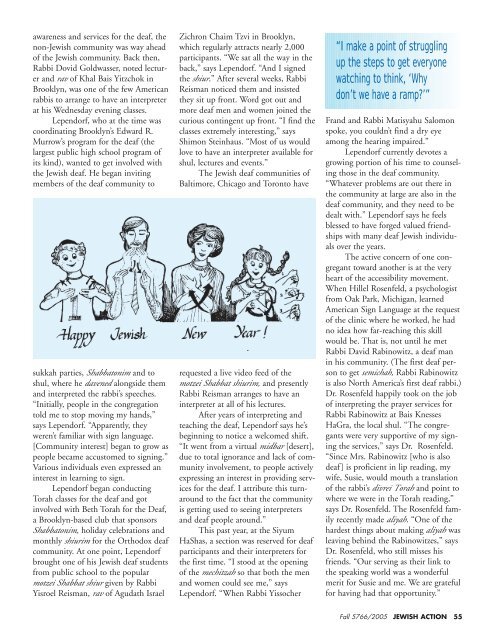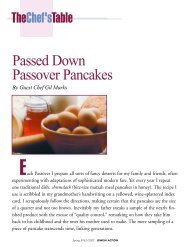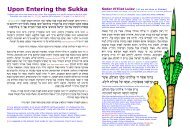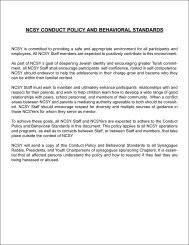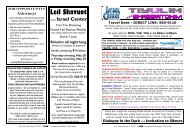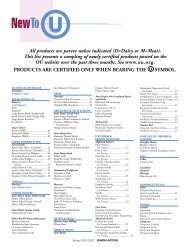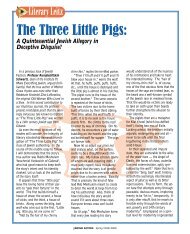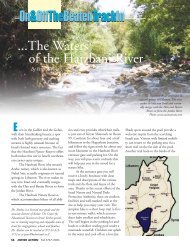welcoming jews with disabilities into jewish ... - Orthodox Union
welcoming jews with disabilities into jewish ... - Orthodox Union
welcoming jews with disabilities into jewish ... - Orthodox Union
You also want an ePaper? Increase the reach of your titles
YUMPU automatically turns print PDFs into web optimized ePapers that Google loves.
awareness and services for the deaf, the<br />
non-Jewish community was way ahead<br />
of the Jewish community. Back then,<br />
Rabbi Dovid Goldwasser, noted lecturer<br />
and rav of Khal Bais Yitzchok in<br />
Brooklyn, was one of the few American<br />
rabbis to arrange to have an interpreter<br />
at his Wednesday evening classes.<br />
Lependorf, who at the time was<br />
coordinating Brooklyn’s Edward R.<br />
Murrow’s program for the deaf (the<br />
largest public high school program of<br />
its kind), wanted to get involved <strong>with</strong><br />
the Jewish deaf. He began inviting<br />
members of the deaf community to<br />
sukkah parties, Shabbatonim and to<br />
shul, where he davened alongside them<br />
and interpreted the rabbi’s speeches.<br />
“Initially, people in the congregation<br />
told me to stop moving my hands,”<br />
says Lependorf. “Apparently, they<br />
weren’t familiar <strong>with</strong> sign language.<br />
[Community interest] began to grow as<br />
people became accustomed to signing.”<br />
Various individuals even expressed an<br />
interest in learning to sign.<br />
Lependorf began conducting<br />
Torah classes for the deaf and got<br />
involved <strong>with</strong> Beth Torah for the Deaf,<br />
a Brooklyn-based club that sponsors<br />
Shabbatonim, holiday celebrations and<br />
monthly shiurim for the <strong>Orthodox</strong> deaf<br />
community. At one point, Lependorf<br />
brought one of his Jewish deaf students<br />
from public school to the popular<br />
motzei Shabbat shiur given by Rabbi<br />
Yisroel Reisman, rav of Agudath Israel<br />
Zichron Chaim Tzvi in Brooklyn,<br />
which regularly attracts nearly 2,000<br />
participants. “We sat all the way in the<br />
back,” says Lependorf. “And I signed<br />
the shiur.” After several weeks, Rabbi<br />
Reisman noticed them and insisted<br />
they sit up front. Word got out and<br />
more deaf men and women joined the<br />
curious contingent up front. “I find the<br />
classes extremely interesting,” says<br />
Shimon Steinhaus. “Most of us would<br />
love to have an interpreter available for<br />
shul, lectures and events.”<br />
The Jewish deaf communities of<br />
Baltimore, Chicago and Toronto have<br />
requested a live video feed of the<br />
motzei Shabbat shiurim, and presently<br />
Rabbi Reisman arranges to have an<br />
interpreter at all of his lectures.<br />
After years of interpreting and<br />
teaching the deaf, Lependorf says he’s<br />
beginning to notice a welcomed shift.<br />
“It went from a virtual midbar [desert],<br />
due to total ignorance and lack of community<br />
involvement, to people actively<br />
expressing an interest in providing services<br />
for the deaf. I attribute this turnaround<br />
to the fact that the community<br />
is getting used to seeing interpreters<br />
and deaf people around.”<br />
This past year, at the Siyum<br />
HaShas, a section was reserved for deaf<br />
participants and their interpreters for<br />
the first time. “I stood at the opening<br />
of the mechitzah so that both the men<br />
and women could see me,” says<br />
Lependorf. “When Rabbi Yissocher<br />
“I make a point of struggling<br />
up the steps to get everyone<br />
watching to think, ‘Why<br />
don’t we have a ramp?’”<br />
Frand and Rabbi Matisyahu Salomon<br />
spoke, you couldn’t find a dry eye<br />
among the hearing impaired.”<br />
Lependorf currently devotes a<br />
growing portion of his time to counseling<br />
those in the deaf community.<br />
“Whatever problems are out there in<br />
the community at large are also in the<br />
deaf community, and they need to be<br />
dealt <strong>with</strong>.” Lependorf says he feels<br />
blessed to have forged valued friendships<br />
<strong>with</strong> many deaf Jewish individuals<br />
over the years.<br />
The active concern of one congregant<br />
toward another is at the very<br />
heart of the accessibility movement.<br />
When Hillel Rosenfeld, a psychologist<br />
from Oak Park, Michigan, learned<br />
American Sign Language at the request<br />
of the clinic where he worked, he had<br />
no idea how far-reaching this skill<br />
would be. That is, not until he met<br />
Rabbi David Rabinowitz, a deaf man<br />
in his community. (The first deaf person<br />
to get semichah, Rabbi Rabinowitz<br />
is also North America’s first deaf rabbi.)<br />
Dr. Rosenfeld happily took on the job<br />
of interpreting the prayer services for<br />
Rabbi Rabinowitz at Bais Knesses<br />
HaGra, the local shul. “The congregants<br />
were very supportive of my signing<br />
the services,” says Dr. Rosenfeld.<br />
“Since Mrs. Rabinowitz [who is also<br />
deaf] is proficient in lip reading, my<br />
wife, Susie, would mouth a translation<br />
of the rabbi’s divrei Torah and point to<br />
where we were in the Torah reading,”<br />
says Dr. Rosenfeld. The Rosenfeld family<br />
recently made aliyah. “One of the<br />
hardest things about making aliyah was<br />
leaving behind the Rabinowitzes,” says<br />
Dr. Rosenfeld, who still misses his<br />
friends. “Our serving as their link to<br />
the speaking world was a wonderful<br />
merit for Susie and me. We are grateful<br />
for having had that opportunity.”<br />
Fall 5766/2005 JEWISH ACTION 55


